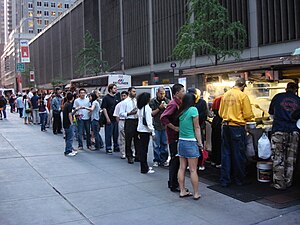
Satay, or sate in Indonesian spelling, is a Southeast Asian form of kebab made from seasoned, skewered and barbecued meat, served with a sauce.

Fast food is a type of mass-produced food designed for commercial resale, with a strong priority placed on speed of service. It is a commercial term, limited to food sold in a restaurant or store with frozen, preheated or precooked ingredients and served in packaging for take-out/takeaway. Fast food was created as a commercial strategy to accommodate large numbers of busy commuters, travelers and wage workers. In 2018, the fast food industry was worth an estimated $570 billion globally.

Kebab, kabob, kebap, or kabab (Kashmir) is roasted meat that originates from the Middle East. Many variants of the category are popular around the world, including the skewered shish kebab and the doner kebab with bread.

Indonesian cuisine is a collection of various regional culinary traditions that formed in the archipelagic nation of Indonesia. There are a wide variety of recipes and cuisines in part because Indonesia is composed of approximately 6,000 populated islands of the total 17,508 in the world's largest archipelago, with more than 1,300 ethnic groups.

Fried rice is a dish of cooked rice that has been stir-fried in a wok or a frying pan and is usually mixed with other ingredients such as eggs, vegetables, seafood, or meat. It is often eaten by itself or as an accompaniment to another dish. Fried rice is a popular component of East Asian, Southeast Asian and certain South Asian cuisines, as well as a staple national dish of Indonesia. As a homemade dish, fried rice is typically made with ingredients left over from other dishes, leading to countless variations. Fried rice first developed during the Sui Dynasty in China.

Phở or Pho is a Vietnamese soup dish consisting of broth, rice noodles, herbs, and meat, sometimes chicken. Phở is a popular food in Vietnam where it is served in households, street-stalls, and restaurants country-wide. Residents of the city of Nam Định were the first to create Vietnamese traditional phở. It is considered Vietnam's national dish.

Rijsttafel, a Dutch word that literally translates to "rice table", is an Indonesian elaborate meal adapted by the Dutch following the hidang presentation of nasi padang from the Padang region of West Sumatra. It consists of many side dishes served in small portions, accompanied by rice prepared in several different ways. Popular side dishes include egg rolls, sambals, satay, fish, fruit, vegetables, pickles, and nuts. In most areas where it is served, such as the Netherlands, and other areas of strong Dutch influence, it is known under its Dutch name.
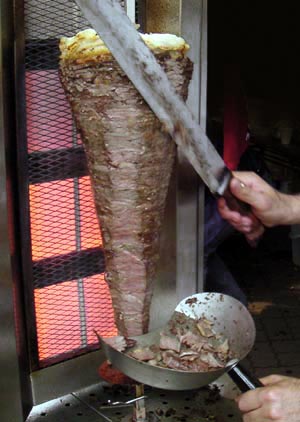
Doner kebab, also spelled as döner kebab, is a dish of Turkish origin made of meat cooked on a vertical rotisserie. Seasoned meat stacked in the shape of an inverted cone is turned slowly on the rotisserie, next to a vertical cooking element. The operator uses a knife to slice thin shavings from the outer layer of the meat as it cooks. The vertical rotisserie was invented in the 19th-century Ottoman Empire, and dishes such as the Arab shawarma, Greek gyros, Canadian donair, and Mexican al pastor are derived from this.

Street food is food sold by a hawker or vendor on a street or at another public place, such as a market, fair, or park. It is often sold from a portable food booth, food cart, or food truck and is meant for immediate consumption. Some street foods are regional, but many have spread beyond their regions of origin. Most street foods are classified as both finger food and fast food and are typically cheaper than restaurant meals. The types of street food vary between regions and cultures in different countries around the world. According to a 2007 study from the Food and Agriculture Organization, 2.5 billion people eat street food every day. While some cultures consider it to be rude to walk on the street while eating, a majority of middle- to high-income consumers rely on the quick access and cheap service of street food for daily nutrition and job opportunities, especially in developing countries.
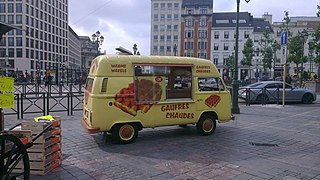
Mobile catering is the business of selling prepared food from some sort of vehicle. It is a feature of urban culture in many countries. Mobile catering can be performed using food trucks, trailers, carts and food stands with many types of foods that can be prepared. Mobile catering is also used to provide food to people during times of emergency.

Mie goreng, also known as bakmi goreng, is an Indonesian stir-fried noodle dish. It is made with thin yellow noodles stir-fried in cooking oil with garlic, onion or shallots, fried prawn, chicken, beef, or sliced bakso (meatballs), chili, Chinese cabbage, cabbages, tomatoes, egg, and other vegetables. Ubiquitous in Indonesia, it is sold by food vendors from street hawkers (warungs) to high-end restaurants.
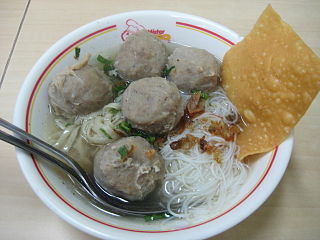
Bakso or baso is an Indonesian meatball, or a meat paste made from beef surimi. Its texture is similar to the Chinese beef ball, fish ball, or pork ball. The word bakso may refer to a single meatball or the complete dish of meatball soup. Mie bakso refers to bakso served with yellow noodles and rice vermicelli, while bakso kuah refers to bakso soup served without noodles.

Regional street food is street food that has commonalities within a region or culture.

Kwetiau goreng is an Indonesian style of stir fried flat rice noodle dish. It is made from noodles, locally known as kwetiau, which are stir-fried in cooking oil with garlic, onion or shallots, beef, chicken, fried prawn, crab or sliced bakso (meatballs), chili, Chinese cabbage, cabbages, tomatoes, egg, and other vegetables with an ample amount of kecap manis. In Asia, kwetiau is available in two forms, dried and fresh. Its recipe is quite similar to another Chinese Indonesian favourite, mie goreng, with the exception of replacing yellow wheat noodles for flat rice noodles.

Mie ayam, mi ayam, or bakmi ayam is a common Indonesian dish of seasoned yellow wheat noodles topped with diced chicken meat. It is derived from culinary techniques employed in Chinese cuisine. In Indonesia, the dish is recognized as a popular Chinese Indonesian dish, served from simple travelling vendor carts frequenting residential areas, humble street-side warung to restaurants.

A halal snack pack is an Australian fast food dish, which consists of halal-certified doner kebab meat and chips. It also includes different kinds of sauces, usually chilli, garlic, and barbecue, whilst yoghurt or yoghurt sauce, cheese, jalapeño peppers and tabbouleh are common additions. While the snack pack was traditionally served in a styrofoam container, it is now most commonly served in moulded pulp or cardboard containers, as most Australian states have banned single-use plastic packaging. The snack pack has been described as a staple takeaway dish of kebab shops in Australia.
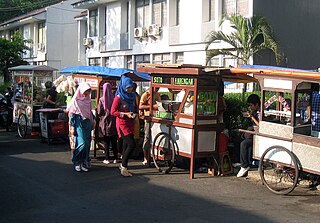
Indonesian street food is a collection of ready-to-eat meals, snacks, fruits and drinks sold by hawkers or vendors at warung food stalls or food carts. Street food in Indonesia is a diverse mix of local Indonesian, Chinese, and Dutch influences. Indonesian street food are usually cheap, offer a great variety of food of different tastes, and can be found on every corner of the city.

Pastil is a Filipino packed rice dish made with steamed rice wrapped in banana leaves with dry shredded beef, chicken, or fish. It originates from the Maguindanao people and is a popular, cheap breakfast meal in Mindanao, especially among Muslim Filipinos. Pastil is also known as patil, patel, patir, or pater in Maranao; and paster in Iranun.
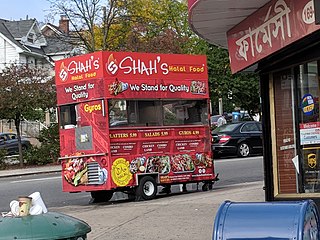
A halal cart is a food cart which serves primarily halal Mediterranean cuisine, particularly in New York City, but also in other metropolitan areas in the United States. A halal cart platter consists of chicken shawarma or lamb gyro, yellow rice, and salad, with optional red and/or white sauce on top. The red sauce is believed to derive from harissa, while the white sauce may come from zabadi. Although they originally served Mediterranean food, they have since expanded to other cuisines.
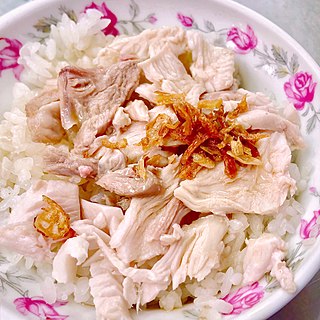
Chiayi turkey rice is a bowl of rice with shredded turkey layered on top, often accompanied by pickled radish. The rice is drizzled with a kind of gravy made from the turkey drippings and soy sauce. It is an iconic specialty from Chiayi County in central Taiwan.
